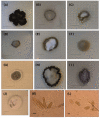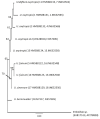Two new species of Undifilum, fungal endophytes of Astragalus (locoweeds) in the United States
- PMID: 24223679
- PMCID: PMC3818909
- DOI: 10.1139/b2012-056
Two new species of Undifilum, fungal endophytes of Astragalus (locoweeds) in the United States
Abstract
New species of Undifilum, from locoweeds Astragalus lentiginosus Vitman and Astragalus mollissimus Torr., are described using morphological characteristics and molecular phylogenetic analyses as Undifilum fulvum Baucom & Creamer sp. nov. and Undifilum cinereum Baucom & Creamer sp. nov. Fungi were isolated from dried plants of A. lentiginosus var. araneosus, diphysus, lentiginosus, and wahweapensis collected from Arizona, Oregon, and Utah, USA, and A. mollissimus var. biglovii, earleii, and mollissimus collected from New Mexico, Oklahoma, and Texas, USA. Endophytic fungi from Astragalus locoweeds were compared to Undifilum oxytropis isolates obtained from dried plant material of Oxytropis lamberteii from New Mexico and Oxytropis sericea from Arizona, Colorado, New Mexico, Utah, and Wyoming. Extremely slow growth in vitro was observed for all, and conidia, if present, were ellipsoid with transverse septa. However, in vitro color, growth on four different media, and conidium size differed between fungi from Astragalus spp. and U. oxytropis. Neighbor-joining analyses of internal transcribed spacer (ITS) region and glyceraldehyde-3-phosphate dehydrogenase (GPD) gene sequences revealed that U. fulvum and U. cinereum formed a clade distinct from U. oxytropis. This was supported by neighbor-joining analyses of results generated from random amplified polymorphic DNA (RAPD) fragments using two different primers.
Keywords: Astragalus lentiginosus; Astragalus mollissimus; Undifilum cinereum; Undifilum fulvum; fungal endophyte.
Figures




References
-
- Achata Böttger JA, Creamer R, Gardner D. Seasonal changes in Undifilum colonization and swainsonine content of locoweeds. J. Chem. Ecol. 2012;38(5):486–495. doi:10.1007/s10886-012-0120-z. PMID:22544335. - PubMed
-
- Berbee ML, Pirseyedi M, Hubbard S. Cochliobolus phylogenetics and the origin of known, highly virulent pathogens, inferred from ITS and glyceraldehyde 3-phosphate dehydrogenase gene sequences. Mycologia. 1999;91(6):964–977. doi:10.2307/3761627.
-
- Braun K, Romero J, Liddell C, Creamer R. Production of swainsonine by fungal endophytes of locoweed. Mycol. Res. 2003;107(8):980–988. doi:10.1017/S095375620300813X. PMID: 14531620. - PubMed
-
- Colegate SM, Dorling PR, Huxtable CR. Spectroscopic investigation of swainsonine – alpha-mannosidase inhibitor isolated from Swainsona-canescens. Aust. J. Chem. 1979;32(10):2257–2264. doi:10.1071/CH9792257.
-
- Cook D, Gardner DR, Ralphs M, Pfister JA, Welch KD, Green BT. Swainsonine concentrations and endophytes amounts of Undifilum oxytropis in different plant parts of Oxytropis sericea. J. Chem. Ecol. 2009;35(10):1272–1278. doi:10.1007/s10886-009-9710-9. PMID:19904570. - PubMed
Grants and funding
LinkOut - more resources
Full Text Sources
Research Materials
Miscellaneous
